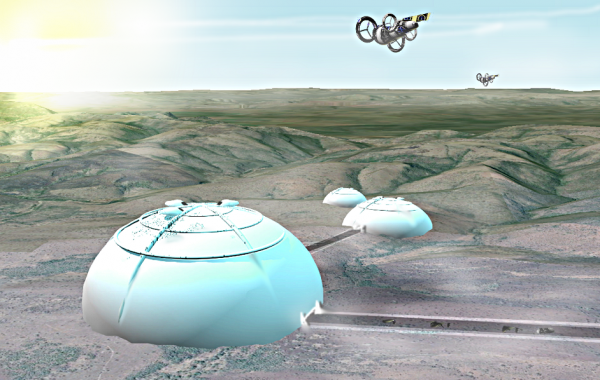BY LETTER
Aysee Tent
Air-conditioned pseudoarcologies within tent-like structures | |
 Image from Steve Bowers | |
| Aysee tent in Southern Africa during the Interplanetary Age | |
The Aysee Tent (also known as an A/C Tent) was a popular pseudo-arcology design originating on Old Earth during the Interplanetary Age. Although it has declined in favour of more advanced alternatives, it has remained in use in some cultures and polities right through to the Current Era.
Design
The first Aysee tents were produced in Southern Africa during the Interplanetary Age, largely in response to the increased temperatures caused by global warming. Many variations on this basic design have since been produced, adapted for different environments or to cater to inhabitants with different needs.Aysee Tent structures are based on Morphable Pressurised Tensegrity Cells (MPTCs) with low enough densities to be aerostatic, supported by lightweight beams. The Tents are erected over large areas of ground, typically over existing settlements or features.
The exteriors are fairly reflective, while still letting through enough light for residents to see their surroundings. This high albedo serves to reflect incident sunlight, contributing to the tent's cooling effect. In some cases in the hottest environments, the tent exteriors can be made entirely white and opaque, and the interiors lit by artificial light or by a small amount of light allowed in through windows.
Aysee Tents often have sizable underground chambers beneath them, with passages emerging both outside and inside the tent. They also have openings near the top, typically equipped with fans to encourage airflow. The flow through these openings pulls up air from within the tent, in turn producing a flow from outside through the underground chambers. By this method, the hot air within the tent is replaced by that from the underground chambers, which is cooler.
In cases where producing subterranean chambers is impractical, tents employ large covered regions along the floor to produce the same effect, with dwellings elevated on stilts or on top of the covered areas. During the Interplanetary Age when the Aysee Tents first become popular, this was more expensive than the basic design, and rather disruptive, but nevertheless proved popular in some cases.
Aysee Tents are generally successful at keeping their interiors at temperatures in the high 20s Celsius, compared to ambient temperatures in the 40s or above.
While modern materials technology has long made very large contiguous tents possible, in the early years larger areas tended to be covered by a number of tent structures with the walls between them removed, supported by large numbers of pillars throughout the covered area.
History
Increasing temperatures combined with high humidity devastated much of the biosphere of Central, Eastern and Southern Africa during the Interplanetary Age, as well as causing a great deal of disruption to the region's societies. This led to the development of arcologies in many African polities. These often became the leaders in arcology-related technologies, which contributed to the rise to economic and cultural pre-eminence of several African nations during the early-to-mid Interplanetary Age.One of the more innovative pseudo-arcology designs, the Aysee Tent, was developed by engineers in Angola and Namibia during the mid-100s AT. The design proved hugely popular, as it did not cause so much disruption to existing settlement structures nor result in the same feeling of claustrophobia sometimes engendered in people moving into arcologies from less built-up environs, especially in rural areas.
The first tents were erected over smaller towns across the hottest regions of Sub-Saharan Africa. This allowed these towns to remain relatively undisrupted, rather than having to go through the extensive infrastructural changes of arcologisation. This would typically have included the adoption of covered walkways and roads and highly compact residential blocks. As materials technology improved, larger and cheaper tent erections became practical. The use of MPTCs in tent-style arcologies was also prominent on Mars, Luna and several other worlds being developed at the time, and so there was high demand for improvements to the technology. Eventually, it became possible to nearly mass-produce the tents, using automated manufactories to produce the structures and AI-guided bots to excavate the subterranean chambers. The cities of Bata (in the Free Peoples' Society) and Lusaka (in the Southern African Democratic Alliance) were put under Aysee Tents during the mid-300s, and their cheapness and availability by the latter part of the century meant that they contributed towards a reversal of the African Hyperurbanisation, in particular being used by individuals seeking to set up new societies, communes and micronations in the African interior.
Being low-tech compared to the more intensive arcologies which continued to house the bulk of most African populations, their inhabitants did not fare quite so badly during the Technocalypse. Many were nevertheless destroyed, and of course all were forced to evacuate by GAIA during the Great Expulsion.
While it did not find much use during the Sundering, the technology was not forgotten, a variety of MPTC-tents continued to be in use. More orthodox forms, resembling those originally used in Africa and other areas of Old Earth, did not come into use again until the development of new terraformed worlds during the Interstellar Era, when the tropical areas of Penglai, Navya-Bharat and Gangirwal all made use of Aysee Tents.
 Image from Steve Bowers | |
| A semi-transparent reflective Aysee Tent on a Junaydan desert world in the Current Era | |
The adaptable and rugged nature of the basic design has meant that Aysee Tents have continued to be used in various places right up to the Current Era, in particular by Hi-tech societies in the Outer Volumes and Periphery. The terraformed desert-heavy worlds in certain expanses of the rimward Outer Volumes known as the Junaydan Bubbles often make use of them, for example.
Related Articles
Appears in Topics
Development Notes
Text by Kirran Lochhead Strang
Initially published on 21 March 2016.
Initially published on 21 March 2016.






